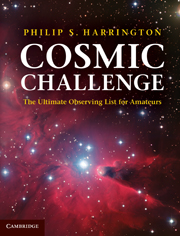Book contents
- Frontmatter
- Contents
- Preface
- Acknowledgments
- Photo credits
- 1 Meeting the challenge
- 2 Naked-eye challenges
- 3 Binocular challenges
- 4 Small-scope challenges: Giant binoculars, 3- to 5-inch telescopes
- 5 Medium-scope challenges: 6- to 9.25-inch telescopes
- 6 Large-scope challenges: 10- to 14-inch telescopes
- 7 Monster-scope challenges: 15-inch and larger telescopes
- Epilogue: The edge of imagination
- Appendix A The cosmic challenge
- Appendix B Suggested further reading
- Appendix C 100 challenging double stars
- Index
6 - Large-scope challenges: 10- to 14-inch telescopes
Published online by Cambridge University Press: 06 December 2010
- Frontmatter
- Contents
- Preface
- Acknowledgments
- Photo credits
- 1 Meeting the challenge
- 2 Naked-eye challenges
- 3 Binocular challenges
- 4 Small-scope challenges: Giant binoculars, 3- to 5-inch telescopes
- 5 Medium-scope challenges: 6- to 9.25-inch telescopes
- 6 Large-scope challenges: 10- to 14-inch telescopes
- 7 Monster-scope challenges: 15-inch and larger telescopes
- Epilogue: The edge of imagination
- Appendix A The cosmic challenge
- Appendix B Suggested further reading
- Appendix C 100 challenging double stars
- Index
Summary
We now enter the realm of double-digit apertures and step into the full depths of the deep-sky ocean. It wasn't that long ago that a 10-inch telescope was considered large by amateur standards. Bringing one to a club star party was a sure way to be the center of everyone's attention, as it stood alone amidst an ocean of 6-inch and smaller telescopes. A 12- or 14-inch telescope practically deified its owner.
Times have changed. Today, these same scopes are no longer the big kids on the block. But that doesn't change the fact that each can still bring its owner a lifetime of enjoyment. Indeed, there are so many challenging objects for these telescopes that trying to settle on the best-in-class is difficult to do. The targets included here represent some of my favorites, but you may well have others that you find equally demanding.
Several of the challenges in the last chapter involved hunting down tiny planetary nebulae. Many planetaries appear very small as seen from Earth, which can make them difficult to tell apart from surrounding stars. This also works in our favor, however, since their small size focuses all of the available light into small disks with high surface brightnesses. Their existence is also accented nicely by using narrowband and oxygen-III filters, which help suppress light pollution. That's why planetary nebulae are far better targets for urban observers than some other types of objects.
- Type
- Chapter
- Information
- Cosmic ChallengeThe Ultimate Observing List for Amateurs, pp. 307 - 366Publisher: Cambridge University PressPrint publication year: 2010

